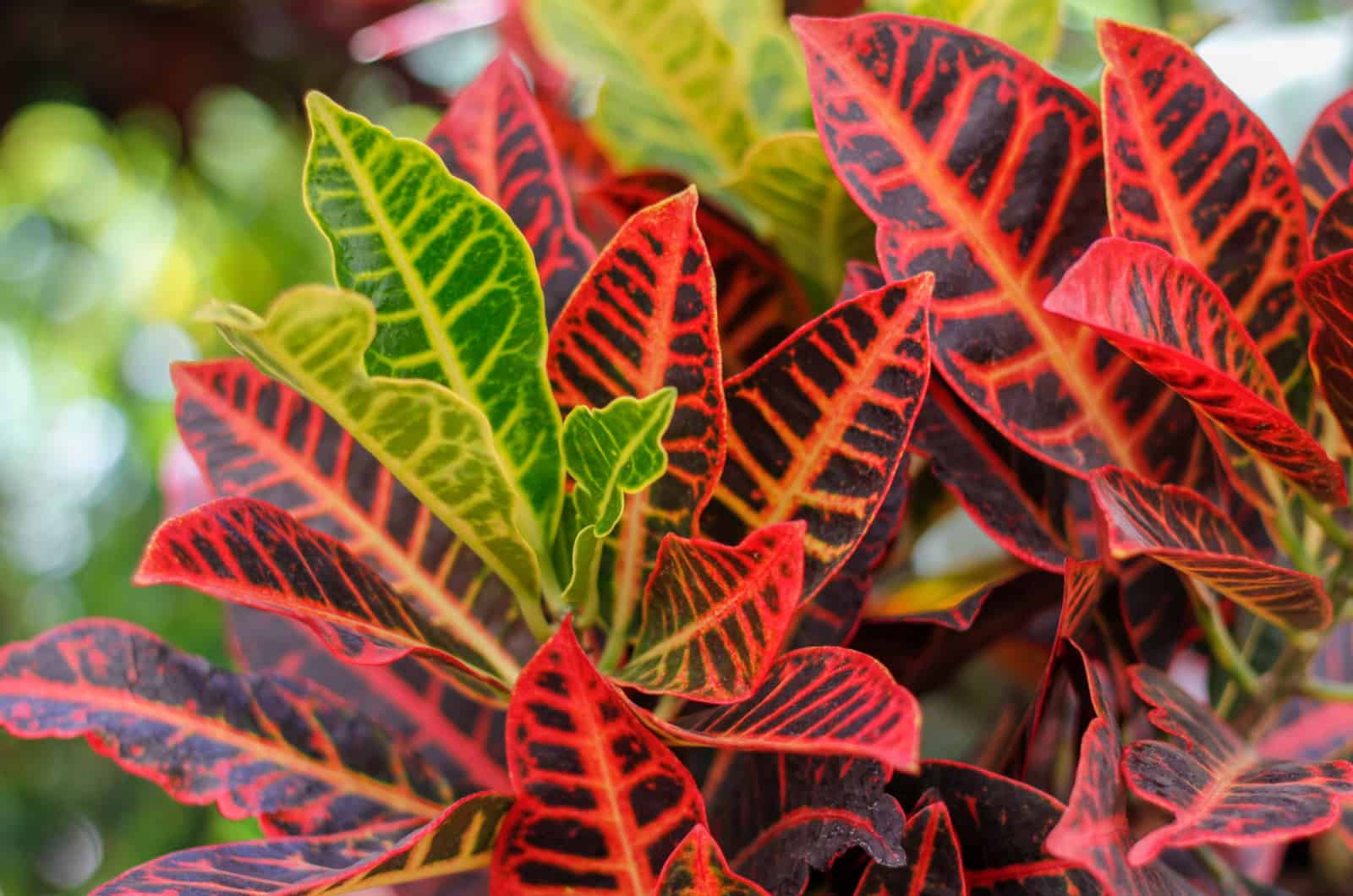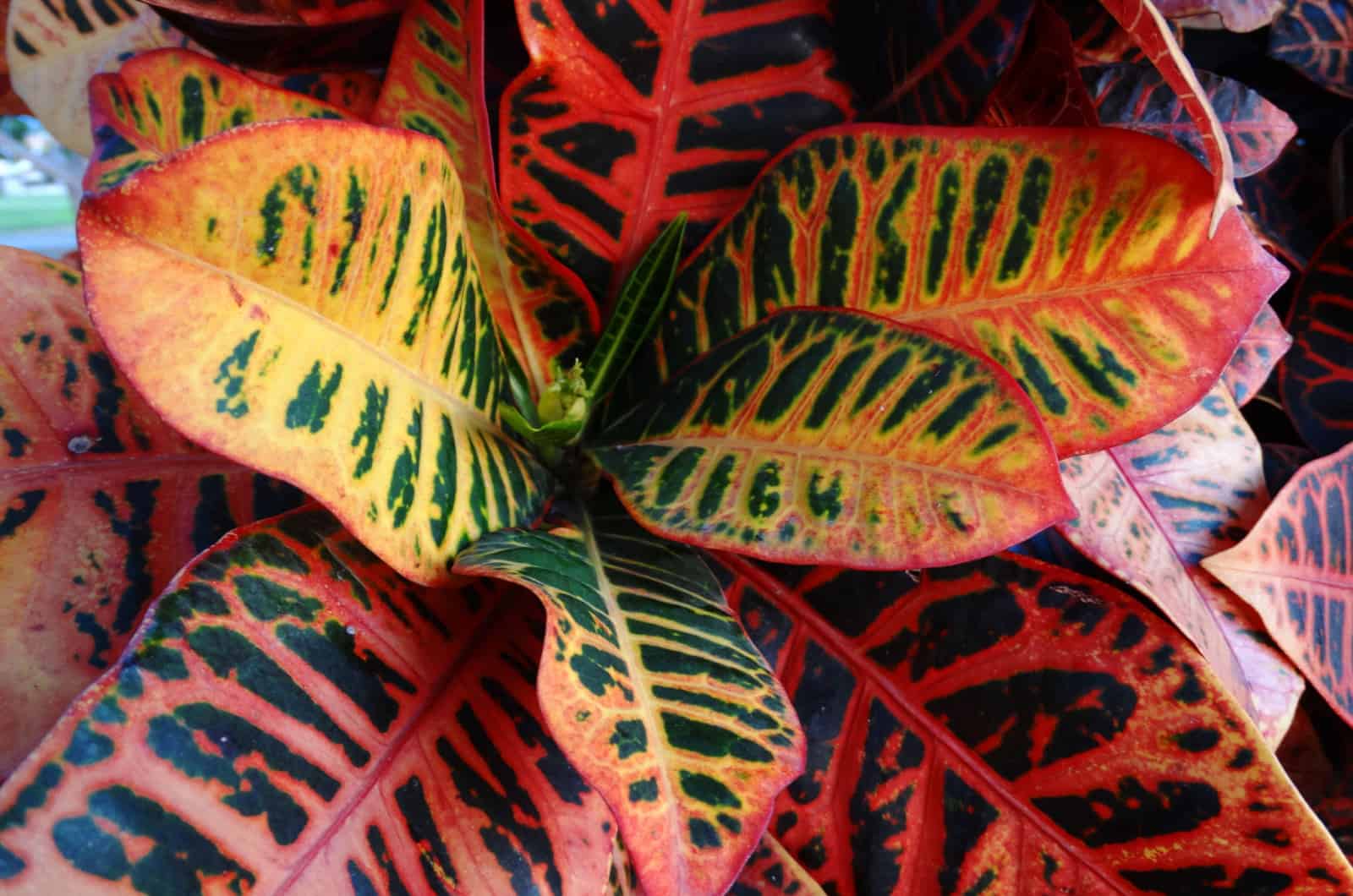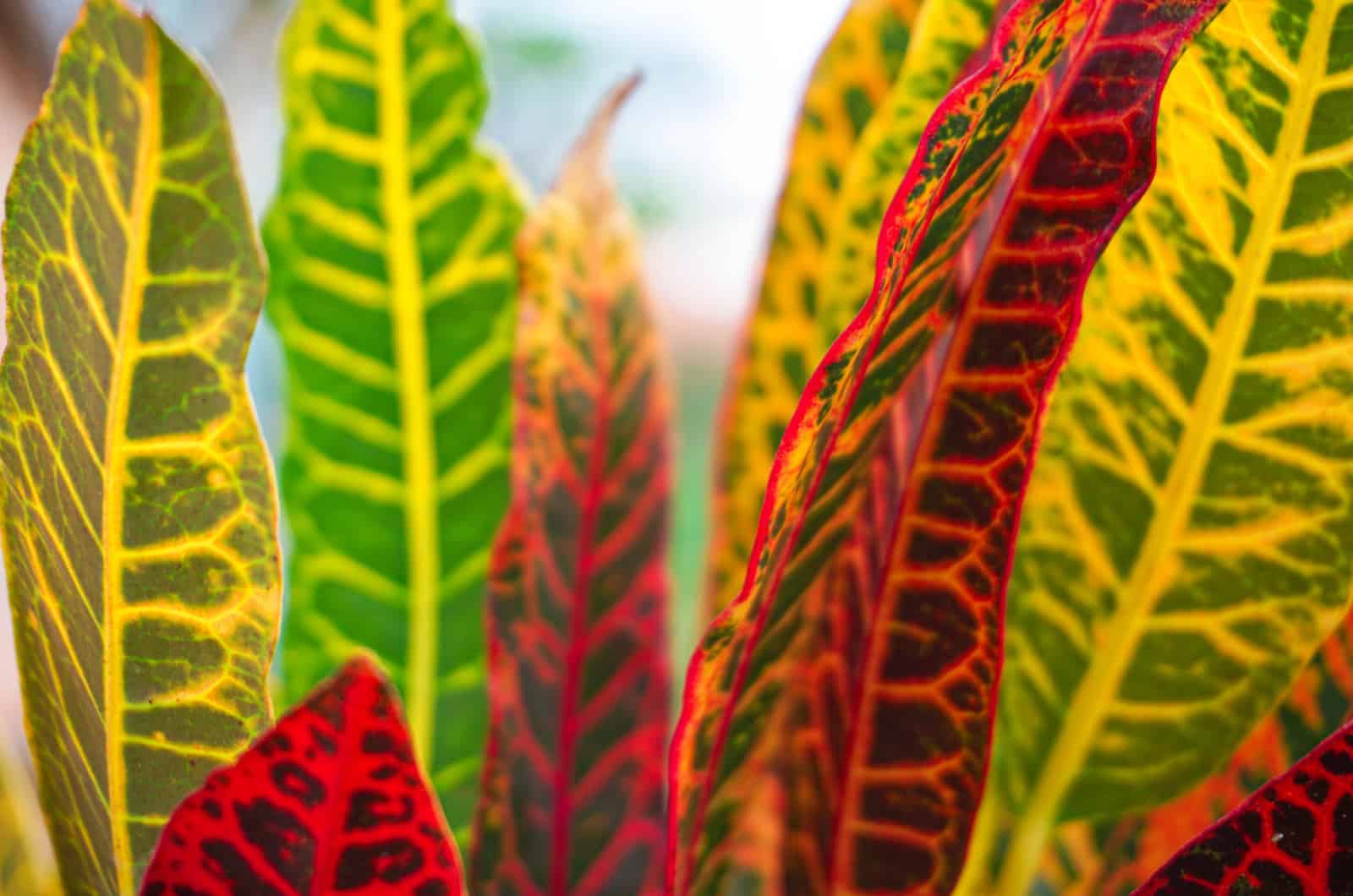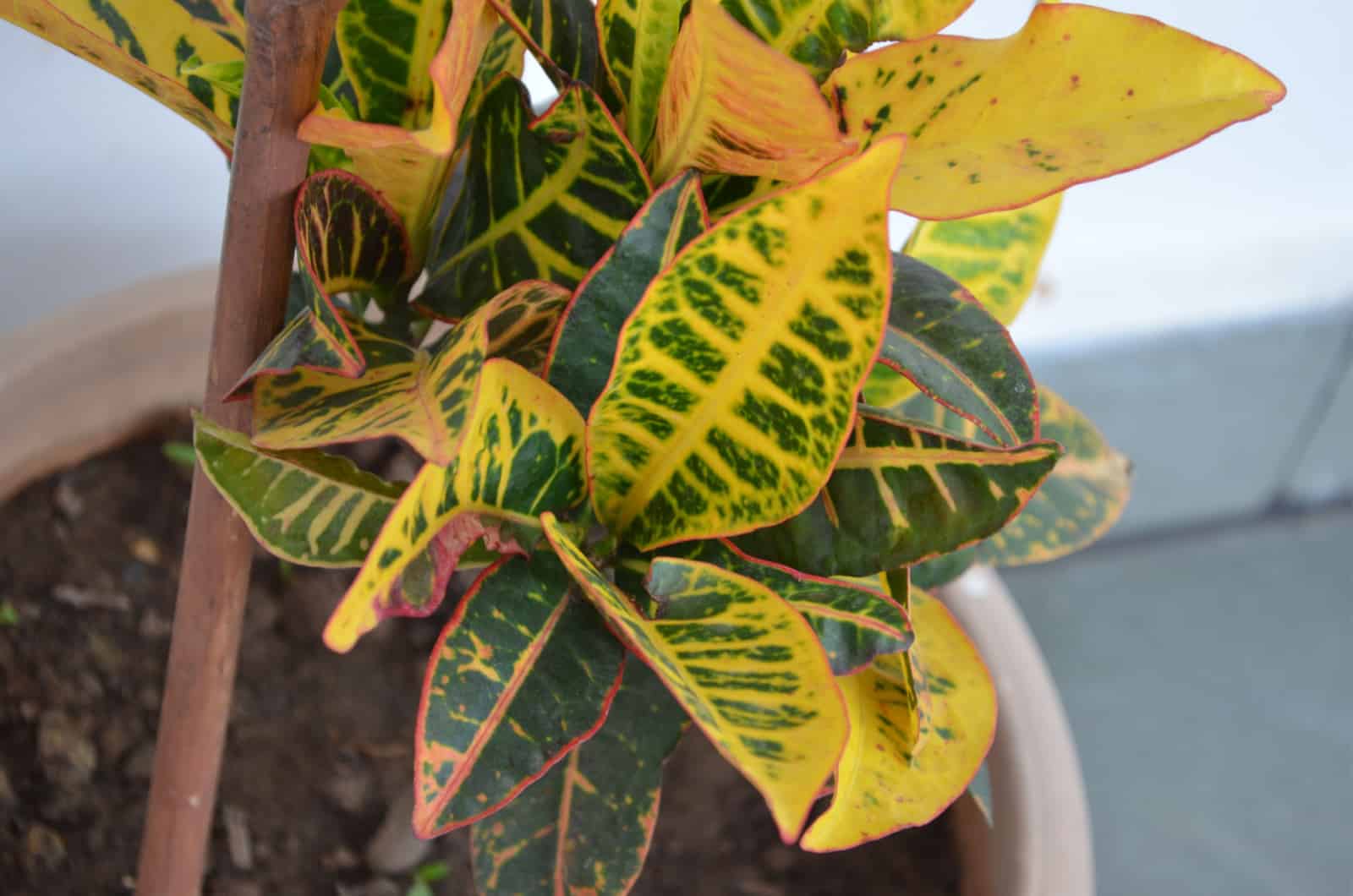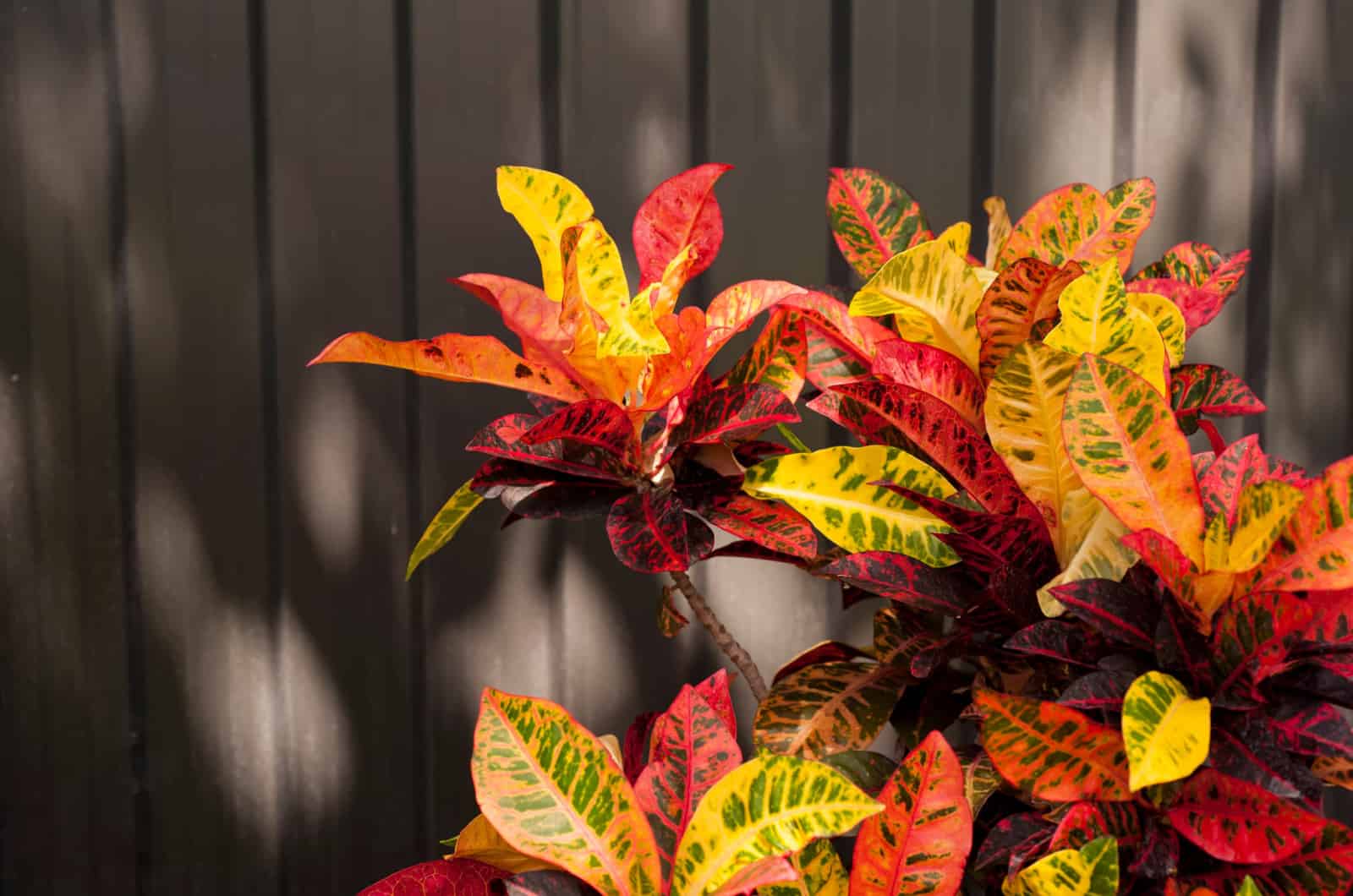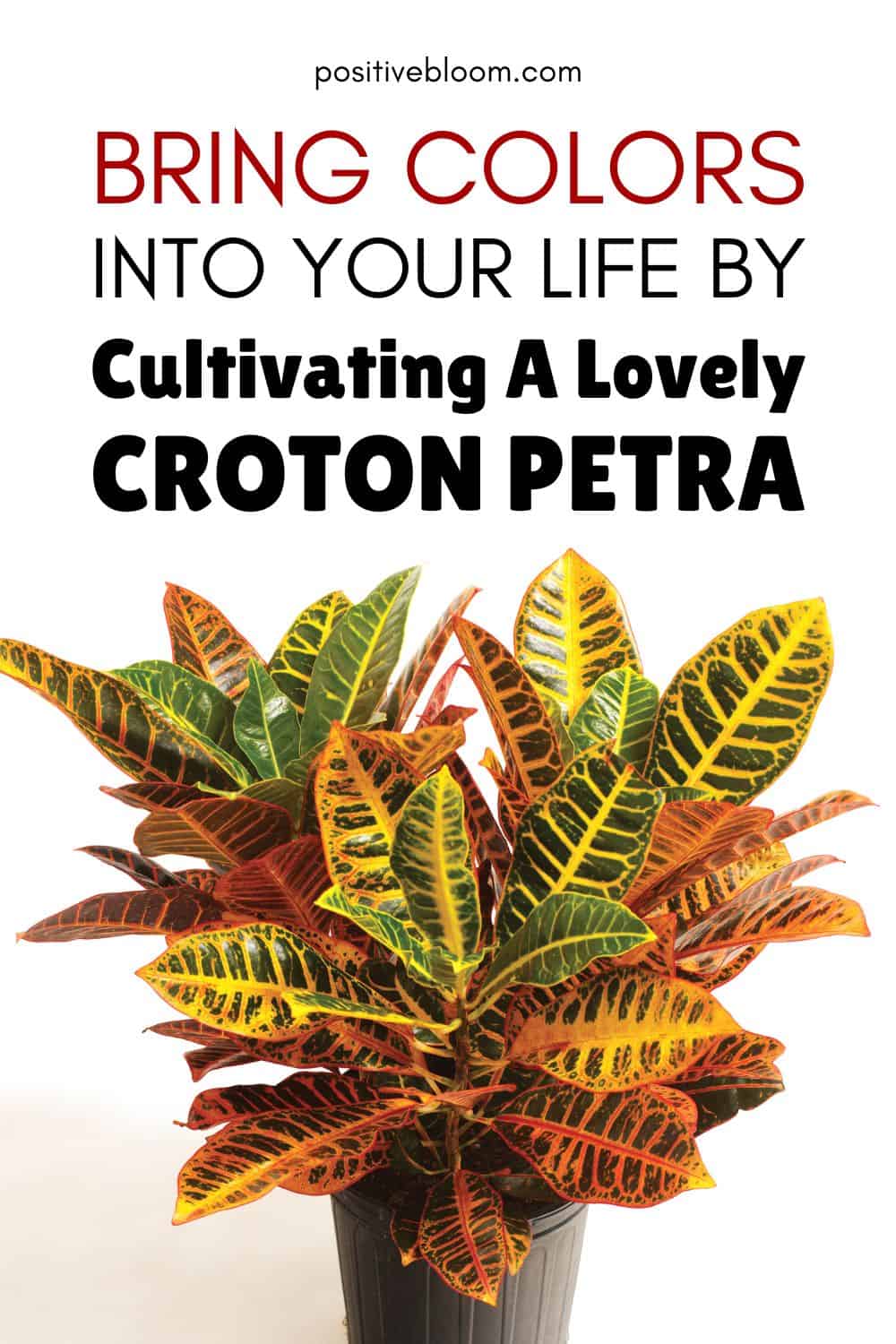If you are looking for a subtle pop of color for your plant collection, then you should definitely consider buying the famous Croton Petra houseplant!
The Croton Petra plant, otherwise known as Codiaeum Variegatum, produces lovely red, pink, orange, and green leaves that can make any room look more lively. On top of their amazing appearance, they are quite easy to take care of, so they are also great indoor plants for all the gardener newbies out there.
Keep reading to learn more about this lovely plant!
Croton Petra: Common Features
The Croton Petra is an evergreen tropical plant that originated from Malaysia, Southeast Asia, Sri Lanka, and Southern India. It belongs to the family Euphorbiaceae.
This plant thrives in USDA hardiness zones 9b to 11, and it prefers warm and humid environments.
Let’s look at some of its other common features!
Plant Size & Growth
The Croton petra plant can grow from 3 to 8 feet tall and 3 to 6 feet wide. It can be hard to tell whether these plants are fast or slow growers because they often produce new leaves. However, you won’t have to worry about repotting because they only need to be repotted once every 2 to 3 years.
What’s interesting is that this plant is known for its colorful and vibrant leaves, but new growth is completely green!
These unique leaves change color as they grow, so you end up with a plant that has various different leaves.
Appearance
This plant is well known for its colorful tropical leaves. They all start off as green, but depending on how much light they get, the leaves change to a beautiful pink, orange, or yellow color.
Variegations are the parts that change the most, while the rest of the leaves stay mostly green.
This lovely and warm color palette of croton leaves will definitely brighten your day!
You can also choose a decorative pot for your tropical beauty, though make sure that it has drainage holes in the bottom!
It will take some time for a new Croton plant to adjust to its new environment — so if your plant seems a bit leggy, just continue with its regular plant care and everything will work out perfectly fine!
Cleaning Air
Did you know there are certain plants that are able to clean the air?
That’s right — according to a NASA study, the Croton Petra plant is one of the best plants at absorbing toxic airborne pollutants, and can give you clean air in your room!
You don’t have to invest in an air freshener; just buy a Croton Petra instead!
You can also combine it with a Snake plant because they are great oxygen suppliers.
Toxicity
One of the biggest downsides of this plant is its toxicity. If ingested, this plant can cause many health problems, such as vomiting, gastrointestinal issues, diarrhea, drooling, and nausea.
It’s especially important to keep your pets away from the plant, as they are more vulnerable and can suffer from severe health issues if they ingest it.
It can also cause skin irritations, so make sure to wear gloves when you are pruning or repotting this plant.
Read also: Is The ZZ Plant Toxic To Cats? Find Out The Answer Here!
How To Take Care Of The Croton Petra
The care guide for the Croton Petra plant is similar to the care guide for most tropical plants. A lot of humidity, plant food, and bright indirect light is what it takes to keep your plant happy and healthy!
Don’t worry if your plant looks leggy in the beginning, it just needs time to adjust to its new home!
Let’s now take a look at some of the basic Croton Petra requirements.
Water Requirements
Tropical plants thrive in moist soil, so it’s important to figure out how to give your plants just the right amount of water to keep them happy and not overwater them.
Overwatering is one of the major issues when taking care of any type of plant. It is often accompanied by root rot, which is a nasty fungal disease that can completely ruin your plant.
It is important to provide them with good drainage in order to prevent overwatering. This includes well-draining soil and also drainage holes in the bottom of the pot to get rid of excess water.
Generally speaking, the Croton Petra plant should be watered once the top few inches of the soil dry out — this way, you will be able to keep the soil moist and not soggy (soggy soil attracts various pests and diseases).
Water them thoroughly, and let the water drain away. The best water for your plant would be lukewarm bottled or filtered water, though you can also use rainwater.
Don’t water them as much during the winter months because they go dormant and don’t require a lot of plant food or water.
Soil Requirements
To ensure that oxygen reaches the plant’s roots, the majority of tropical plants need potting soil that drains well and is porous.
The ideal potting mix for the Croton plant consists of coco coir, sphagnum moss, orchid bark, and perlite, though you can add any kind of soil additive that improves drainage.
Some growers add a layer of gravel at the bottom — this is usually done in succulent terrariums to provide good drainage.
Please remember that they like a lot of plant food, so you can also use humus-rich soil.
Light Requirements
Light conditions are also very important because they affect the beautiful leaves the most.
Croton Petra plants need at least 6 hours of bright indirect sunlight throughout the day. They can also grow in full sun (they are usually grown as trees or shrubs outdoors), though sometimes direct sunlight can burn their lovely leaves.
However, they produce colorful leaves when grown in bright light!
These plants can tolerate low lights as well, though their leaves would be much greener.
Find a perfect location in your house because constantly changing where you keep your plant can lead to droopy leaves. You can also invest in grow lights if your room is very dark.
Humidity Requirements
We have already mentioned that these plants absolutely love high humidity!
They prefer growing in humidity levels from 40 to 80 percent.
If you live in a dry environment, you should look into ways to increase humidity.
Fortunately, there are a few easy methods to increase humidity. One simple answer is to get a humidifier that you can turn on and off automatically. You won’t even have to spend much money because humidifiers are no longer as expensive as they once were.
You can also make a pebble tray by placing some pebbles in a tray, covering them with water, and then placing your plant on top. Your plant will receive just the right amount of moisture as the water in the tray evaporates.
You can also try misting your plant every day or placing it somewhere with higher humidity, such as a bathroom or kitchen (just make sure that they get proper lighting).
Please keep in mind that low humidity can make your plant more susceptible to spider mites!
Temperature Requirements
This plant will flourish in high temperatures because tropical regions are very warm.
It doesn’t have to be 100 degrees, so don’t worry!
Simply attempt to maintain a temperature of at least 60 degrees Fahrenheit. Also bear in mind that anything above 80 degrees Fahrenheit can harm your plant.
The plant must be kept away from all heat sources, including radiators and space heaters, in order to avoid stressing out this tropical beauty. Heat also increases the need for moisture.
Keep in mind that this plant doesn’t fare well in cold drafts, so keep it away from vents and air conditioners as well.
Fertilizer Requirements
These plants need some nutrients throughout the growing season in order to produce pretty, multicolored leaves.
You can use slow-release fertilizer at the beginning of the growing season (usually in early spring), though these plants are commonly fertilized with an organic fertilizer that’s applied once a month — but only during the growing season because they go dormant in winter!
You can also use liquid fertilizers, which are usually applied weekly.
Nitrogen-rich fertilizers are ideal for these plants, and you can also use a fertilizer with a 3-1-2 formula.
Pruning
These plants are often pruned to encourage new and lush growth, and also to maintain a specific plant shape. Use clean pruning shears to remove any dead or decaying leaves, and always cut the leaves at their bases, not just the damaged portion.
You can also pinch back the stems to encourage branching and obtain a bushier appearance.
Avoid pruning during the growing season when the plant is at its peak of growth. Prune them during the winter season instead.
Repotting
If your plant has stopped growing and the roots have started coming out of the drainage holes, it means it has outgrown its current pot, and it’s time for repotting!
Get a new pot that is 2 inches larger than the current one. Make sure that it has drainage holes in the bottom.
When repotting, use fresh soil to replenish nutrients.
Check the roots of your plant, and if you notice any decaying or dead roots, trim them off because they might be affected by root rot. Be careful because this plant can easily get transplant shock.
Put the repotted plant in a place where it can get plenty of bright light, and water it thoroughly.
Propagation
Croton Petra propagation is simple and beginner friendly. Follow these easy steps to propagate your plant:
1. Find a section with a few healthy leaves that is at least three inches long.
2. Use a clean blade or set of pruning shears to cut just above the leaf node.
3. Prepare a small pot with drainage holes in the bottom filled with well-draining soil.
4. Put the cutting in the new pot and cover it with plastic wrap to create a humid environment.
5. Put the pot in bright indirect light and keep the soil moist.
Common Issues With The Croton Petra
Unfortunately, the Croton Petra plant is prone to some pests and diseases. It’s such a shame to see its lovely leaves wilting and drooping!
However, all is not yet lost, and you can find a way to fix the issue and get your plant back on track. The most important thing is identifying the issue and finding its specific solution as quickly as possible
Leaves Losing Color
Those warm-colored leaves are one of the main reasons these plants gained popularity so quickly, which is why seeing them lose color is so tragic.
Improper light conditions are the biggest cause of the leaves losing their colorful variegations. They tend to stay green if they don’t get at least 6 hours of bright light during the day.
Nonetheless, the plant still looks very lovely; but if you are looking for a subtle pop of color, make sure the plant receives plenty of light!
Brown & Droopy Leaves
Droopy leaves are usually caused by inadequate watering.
You could be either overwatering or underwatering your plant. If you are overwatering, the soil will be soggy and the leaves will look yellow and droopy.
In the case of underwatering, the soil would be compact and bone dry, and the leaves would be yellowing and turning brown. Brown leaf edges might also be a sign of overfertilization.
Too much direct sunlight during the hot summer days might also burn the leaves, making them look crispy and brown.
Lack of humidity might also be a reason your plant looks sad and droopy.
Carefully follow the care guide above if you want to keep your plant happy and healthy!
Pest Infestations
We mentioned that the Croton Petra plant is susceptible to spider mites when humidity levels are low. However, other pests like mealybugs, scales, and white flies might also pay your plant a visit!
Common symptoms of pest infestations are discolored leaves, spots on the leaves, wilting, and stunted growth.
Check the undersides of the leaves because most pests tend to settle there and suck away at the nutritious plant juice. You might also spot spider eggs in the soil, which is a sign of spider mites infestations.
These are usually treated with pesticides or neem oil.
Plant Diseases
Some of the diseases that can affect your Croton Petra plant include:
• Bacterial leaf spot — this infection results in leaf lesions that turn yellow and fall off. If not treated, bacterial leaf spot can kill your Croton Petra and spread to your other houseplants.
• Canker — this disease is caused by numerous fungi, and it primarily affects the leaves. If you see dark brown or black spots on the leaves, treat the plant with fungicides.
• Anthracnose — brown patches and lesions are usually signs of Anthracnose. In severe cases, the foliage may even begin to drop.
• Stem Gall — Inger’s protomyces macrosporus causes stem gall. Blisters can be seen on the leaves and stems of diseased plants, and infected plants also generate seeds that are malformed, hypertrophied, and hard.
To stop diseases from spreading to your other houseplants, you must quickly isolate the diseased plant. Copper fungicides are typically used to treat fungus, though neem oil can also be used.
Make sure your Croton plants receive the proper amount of water because overwatering is frequently the cause of many diseases.
FAQs
1. What are the benefits of having a Petra Croton in your home?
As well as mesmerizing leaves decorating your home, the plant is also able to absorb toxic airborne pollutants to clean your air!
Therefore, some of the benefits of having Petra Croton in your home include killer decorations and a free air freshener. The lovely multicolored leaves produced by this plant can make any room look more lively and vibrant.
2. Is the Croton Petra a good indoor plant?
The Croton Petra is a great indoor plant!
It doesn’t take you a lot of time and effort to create the perfect environment for this plant. All you have to do is make sure the plant receives plenty of bright light so that its variegations can change colors, and water them frequently to keep the soil moist.
Fertilize the plant during the growing season, and make sure to keep it in temperatures above 60 degrees Fahrenheit.
High humidity is also crucial for this plant’s well-being.
To Sum Up
The Croton Petra is definitely one of the prettiest plants that you can grow both indoors and outdoors. Those multicolored leaves will make any room look more vibrant, especially if you are aiming for clean and minimalist aesthetics for home decor.
Even though it might seem like they are hard to grow, it is quite easy to take care of these plants. Just make sure that the Croton Petra plant gets a lot of light, an adequate amount of water, and high humidity!
Fertilize them every now and then, and you are good to go!
I hope this article was helpful.
Until next time!
Like this post? Share or pin it for later!

